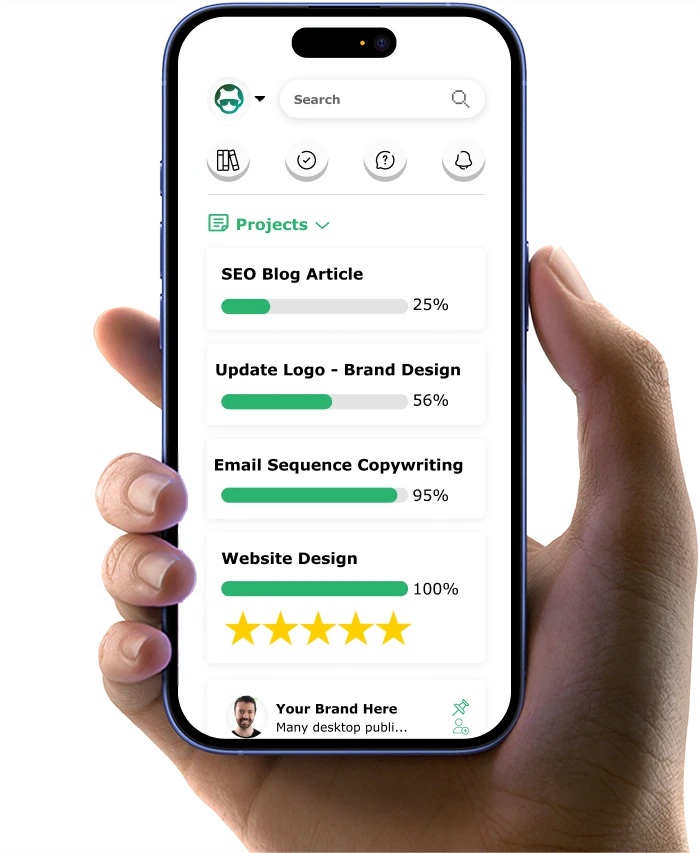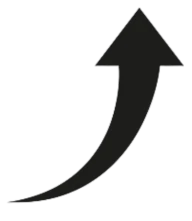11 Clear Tips for Webinar Follow-Up Emails

You pour your energy into crafting a webinar with valuable insights, thoughtful content, meaningful connection and when it's over, there's... crickets. It’s frustrating, right? So many coaches experience this. The truth is, the follow-up isn’t just a nice-to-have; it’s the bridge between showing up and signing clients. Without it, all that hard work risks fading into the background, unseen and unheard.
Many coaches, like you, face the challenge of effectively following up with participants. A simple email often isn’t enough. You need a strategy that captures attention and encourages action. This article will guide you through essential steps to improve your webinar follow-up process.
By reading on, you will discover:
- The secret to personalizing your follow-up emails to forge a stronger connection with your audience.
- How to craft subject lines that not only grab attention but also compel recipients to open your emails.
- Ways to highlight key insights from your webinar that motivate attendees to take the next step.
- Effective techniques for creating clear calls-to-action that guide your audience on what to do next.
- Strategies for collecting feedback that will help you improve future communications.
Let’s dive into these strategies and explore how you can effectively engage your audience after your next webinar...
If you want to get your marketing work done for your business (or for your clients’), then you HAVE to learn more how you can delegate unlimited marketing projects & tasks without the headaches of hiring. Download this free guide: 33 Examples of Marketing Projects You Can Delegate to Growbo
Follow-Up Email Tip #1: Personalize Your Email
When it comes to webinar replay follow-up email sequences, personalization is key. You might be wondering why personalizing your emails matters so much. Well, studies show that personalized emails can significantly enhance client engagement and retention. Woodpecker reports that advanced personalized emails achieve a 17% response rate, compared to just 7% for non-personalized emails.
This means that when you take the time to tailor your messages to your audience, you are not just sending another generic email. You are creating a connection that makes your recipients feel valued and understood. For instance, addressing your recipients by their first name and referencing specific points from the webinar can make a huge difference. It shows that you are paying attention and care about their individual needs.
Building on this, consider segmenting your audience based on their interests or engagement levels during the webinar. This allows you to craft messages that resonate more deeply with each group. By doing so, you can direct your follow-up emails to highlight aspects of the webinar that align with their specific interests, further increasing the likelihood of engagement.
Key insights from this section include:
- The impact of personalized emails on engagement and retention.
- The importance of addressing recipients by name and referencing their interests.
- Benefits of audience segmentation for more targeted follow-ups.
By implementing these strategies, you can create a more effective follow-up email sequence that not only captures attention but also fosters lasting relationships with your audience.
Follow-Up Email Tip #2: Create a Compelling Subject Line
When sending out your webinar replay follow-up email sequences, the subject line is your first impression. You might be wondering why a subject line matters so much. Well, it’s the deciding factor for whether your email gets opened or ignored. Research from Zoom shows that emails with compelling subject lines can increase open rates by up to 50%.
To create an effective subject line, focus on clarity and relevance. Make sure it reflects the content of your email while also sparking curiosity. For instance, instead of a generic "Webinar Replay Available," consider something more engaging like "Unlock Key Insights from Our Recent Webinar!" This not only informs the recipient but also entices them to learn more.
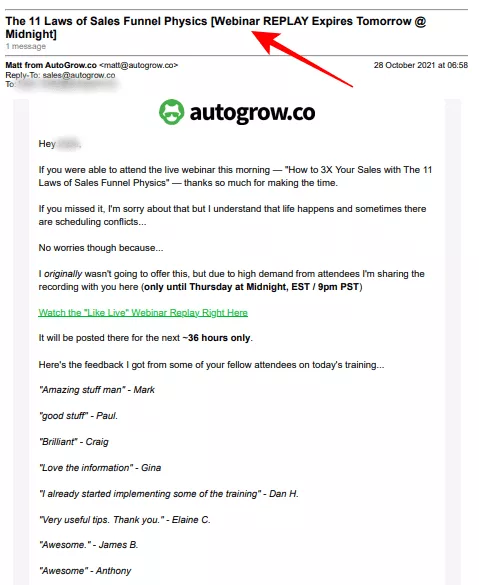
Another effective strategy is to personalize your subject lines. Using the recipient's name or referencing specific topics discussed in the webinar can significantly boost open rates. For example, "[Name], Here’s Your Exclusive Webinar Replay on [Topic]!" This personalized touch makes the email feel more relevant and tailored to the individual.
Key insights from this section include:
- The importance of compelling subject lines for increasing open rates.
- Strategies for creating engaging and relevant subject lines.
- The benefits of personalizing subject lines to enhance engagement.
By applying these techniques, you can create subject lines that not only grab attention but also encourage your audience to engage with your content.
Follow-Up Email Tip #3: Recap the Webinar Highlights
After your webinar, it's essential to remind your audience of the value they received by recapping the highlights in your webinar replay follow-up email sequence. You might be wondering how this can help in converting leads into clients. Well, summarizing key points not only reinforces the information shared but also serves as a prompt for attendees to take action.
According to a study by LinkedIn, 79% of webinar attendees appreciate receiving a recap of the main highlights. This reinforces their learning and keeps the content fresh in their minds. By including a recap, you remind your audience of the valuable insights they gained and how those insights can impact their work or decisions.
When crafting your recap, focus on the most impactful moments from the webinar. Highlight actionable takeaways and any data or statistics that were shared. For example, if you discussed a specific strategy that can help coaches increase client engagement, summarize that strategy succinctly. This not only reinforces the content but also encourages recipients to implement what they learned.
This is what our post-webinar email presented in the recap:
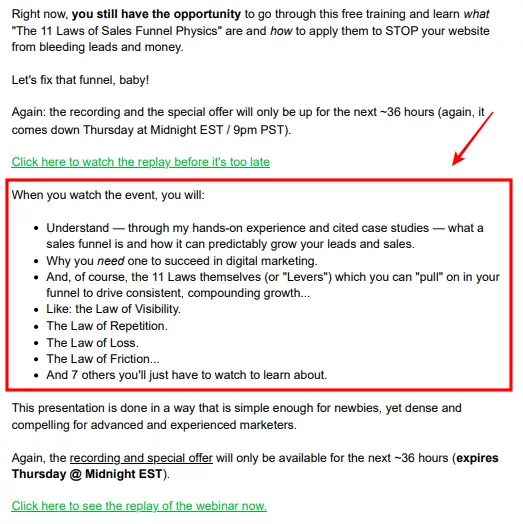
Key insights from this section include:
- The importance of recapping key highlights to reinforce learning.
- Statistics showing that attendees appreciate recaps.
- Strategies for summarizing actionable takeaways effectively.
By providing a thoughtful recap, you can enhance the effectiveness of your follow-up email sequence and encourage your audience to engage further with your offerings.
Follow-Up Email Tip #4: Include a Clear Call-to-Action (CTA)
One of the most critical components is the clear call-to-action (CTA). You might be wondering why a CTA is so important. A well-crafted CTA directs your audience on what to do next, whether it’s to schedule a consultation, download additional resources, or sign up for your next webinar. According to HubSpot, emails with a single call-to-action can increase clicks by over 371%.
When creating your CTA, make sure it is specific and compelling. Use action-oriented language that encourages immediate response. For example, instead of saying "Click here for more information," consider using "Schedule Your Free Consultation Today!" This not only tells the recipient what to do but also adds a sense of urgency that can motivate them to act.
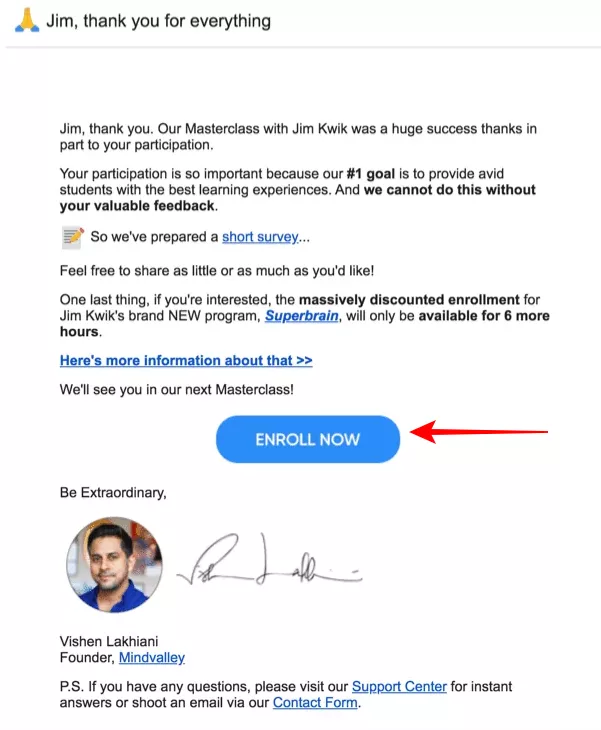
Additionally, consider the placement of your CTA within the email. It should be easily visible and strategically positioned, ideally after you’ve summarized the value of your webinar. This way, recipients are more likely to take action after they’ve been reminded of the benefits they could gain. You can even include multiple CTAs throughout the email, but ensure they all lead to the same goal to avoid confusion.
Key insights from this section include:
- The importance of a clear and compelling CTA in driving engagement.
- Statistics showing the effectiveness of single CTAs in increasing click-through rates.
- Strategies for crafting actionable language and optimal placement of CTAs.
By incorporating a strong CTA in your follow-up emails, you can significantly enhance your chances of converting leads into clients and guiding them to take the next steps.
Follow-Up Email Tip#5: Offer Additional Resources
Offering additional resources can significantly enhance the value you provide to your audience. You might be wondering how this can impact your engagement rates. Well, providing extra resources not only reinforces the content of your webinar but also positions you as a helpful and knowledgeable resource for your audience.
According to research from Codeless, 69% of webinars provide downloadable resources to engage their attendees. By including links to eBooks, articles, or relevant blog posts, you can deepen their understanding and keep them engaged with your content long after the webinar has ended.
When selecting additional resources to share, consider what would be most beneficial for your audience. For instance, if your webinar covered strategies for improving client engagement, you might include a link to a detailed guide on implementing those strategies or a case study showcasing successful outcomes. This not only adds value but also encourages recipients to explore more of your offerings.
Key insights from this section include:
- The importance of offering additional resources to enhance value.
- Statistics showing that attendees appreciate receiving extra materials.
- Strategies for selecting relevant resources to share with your audience.
By providing these additional resources in your follow-up emails, you can foster a stronger connection with your audience and encourage them to engage further with your services.
Follow-Up Email Tip #6: Segment Your Audience
Segmenting your audience is a crucial step. You might be wondering how segmentation can improve your email engagement. Well, tailoring your messages to specific groups within your audience can lead to significantly higher response rates. In fact, research from Mailchimp shows that segmented email campaigns achieve 14.31% higher open rates compared to non-segmented campaigns.
When you segment your audience, you can send more relevant and personalized content that resonates with each group. For example, if your webinar attracted both new coaches and experienced professionals, you could create different follow-up messages that address the unique challenges and interests of each group. This targeted approach not only increases the likelihood of engagement but also builds a stronger connection with your audience.
Additionally, consider using data from your webinar registration forms or engagement metrics to inform your segmentation strategy. By analyzing which topics generated the most interest or which attendees asked the most questions, you can tailor your follow-up content to meet their specific needs. This level of personalization can significantly enhance the effectiveness of your follow-up emails.
This is an example of a simple segmenented webinar follow up email:
Key insights from this section include:
- The importance of audience segmentation for improving engagement.
- Statistics showing the effectiveness of segmented email campaigns.
- Strategies for using data to inform your segmentation approach.
By implementing audience segmentation in your follow-up emails, you can create a more impactful communication strategy that resonates with your audience and encourages them to take action.
Follow-Up Email Tip #7: Automate Your Follow-Up Sequence
Automating your follow-up sequence is a game-changer for your follow-up email sequence. You might be wondering how automation can enhance your email strategy. Well, automating your emails allows you to send timely follow-ups without the hassle of managing each message manually. A study from Campaign Monitor shows that automated emails can generate 320% more revenue than non-automated emails.
To get started with automation, consider using platforms like ActiveCampaign or Mailchimp. These tools offer user-friendly features that allow you to set up your email sequences effortlessly. For instance, you can create triggers based on user behavior, such as opening your initial email or clicking on a link. This means your audience receives targeted follow-ups based on their engagement level, ensuring they get relevant content at just the right time.
Moreover, automating your follow-up sequence helps maintain consistency in your messaging. By scheduling your emails in advance, you ensure that your audience receives a steady stream of communication without any gaps or delays. This consistent engagement reinforces your brand and keeps your content fresh in their minds.
Key insights from this section include:
- The benefits of automating follow-up emails for efficiency.
- Statistics showing the revenue potential of automated emails.
- Strategies for using automation tools to enhance engagement.
By incorporating automation into your follow-up email strategy, you streamline your processes and significantly boost your chances of converting leads into clients.
Follow-Up Email Tip #8: Test and Optimize Your Emails
Testing and optimizing your follow-up emails is a vital part of your webinar replay follow-up email sequence. You might be wondering how testing can improve your email effectiveness. Well, A/B testing different elements of your emails—such as subject lines, content, and CTAs—can provide valuable insights into what resonates best with your audience. Strikepointmedia reports that diligent use of A/B testing helped achieve a 30% increase in click-through rates.
To start, identify one element to test at a time. For example, you might want to experiment with two different subject lines for the same email. After sending both versions, analyze the results to see which subject line achieved a higher open rate. This data-driven approach allows you to refine your emails based on actual audience behavior, rather than assumptions.
Additionally, consider optimizing your emails based on the feedback and engagement metrics you gather. If you notice that certain content types or topics generate more interest, adjust your future emails to reflect those preferences. Continuously optimizing your follow-up emails ensures that you are providing relevant and engaging content that meets the needs of your audience.
Key insights from this section include:
- The importance of testing and optimizing follow-up emails for effectiveness.
- Statistics showing the impact of A/B testing on click-through rates.
- Strategies for using audience feedback to refine email content.
By implementing a robust testing and optimization strategy, you can enhance the performance of your follow-up emails and increase your chances of converting leads into clients.
Follow-Up Email Tip #9: Gather Feedback for Improvement
Gathering feedback from your audience is an essential step in refining your follow-up email sequence. You might be wondering how feedback can improve your emails. Soliciting input from your recipients allows you to understand their needs and preferences better, leading to more effective communication. HubSpot reports that 70% of customers who have a positive experience after providing feedback are more likely to become loyal advocates.
To effectively gather feedback, consider including a short survey or a simple question at the end of your follow-up emails. Ask recipients what they found most valuable about the webinar or if there are topics they would like to see covered in the future. This not only shows that you value their opinions but also provides you with actionable insights that can guide your content creation.
Additionally, analyzing engagement metrics such as open rates and click-through rates can serve as indirect feedback. If certain topics or emails generate more interest, use this information to tailor your future communications.
Key insights from this section include:
- The importance of gathering feedback to improve future emails.
- Statistics showing the impact of feedback on customer satisfaction.
- Strategies for soliciting feedback effectively.
By actively seeking feedback, you can continuously enhance your follow-up emails and better meet the needs of your audience.
Follow-Up Email Tip #10: Follow Up Again
Following up again after your initial emails can significantly increase your chances of converting leads into clients. You might be wondering why a secondary follow-up is necessary. Many leads may not respond to your first email for various reasons, and a gentle reminder can prompt them to take the desired action. Additionally, Klenty reports that sending a second follow-up email increases your chances of getting a reply by 25%.

When crafting your follow-up message, keep it concise and friendly. Acknowledge that they may have missed your previous email and reiterate the value of your webinar content. For example, you might say, "I wanted to follow up on my previous email to ensure you received the webinar replay. It contains valuable insights that can help you [specific benefit]." This approach serves as a reminder while emphasizing the benefits of engaging with your content.
Moreover, consider offering a limited-time incentive, such as a free consultation or a discount on your services, to encourage recipients to take action. This can create a sense of urgency that prompts them to respond.
Key insights from this section include:
- The significance of sending a secondary follow-up to increase response rates.
- Statistics showing the effectiveness of follow-up emails.
- Strategies for crafting friendly and effective follow-up messages.
Follow-Up Email Element #11: Keep the Conversation Going on Other Channels
After sending your webinar replay follow-up emails, don’t stop there, expand your reach by continuing the conversation on other platforms. You might be wondering why this matters. Well, not everyone checks their email regularly, and even if they do, your message might get buried. Staying visible on social media or through direct messaging helps reinforce your value and keeps you top of mind.
According to HubSpot, 60% of prospects say "no" four times before saying "yes". By diversifying your follow-up strategy beyond email, you're creating more opportunities for your audience to engage with you.
When doing this, avoid being salesy. Focus on being helpful and accessible. For instance, you might say: “Hey [Name], just wanted to thank you again for joining the webinar. Let me know if you have any questions about [topic covered]—happy to help!”. This keeps the relationship warm and open for further dialogue.
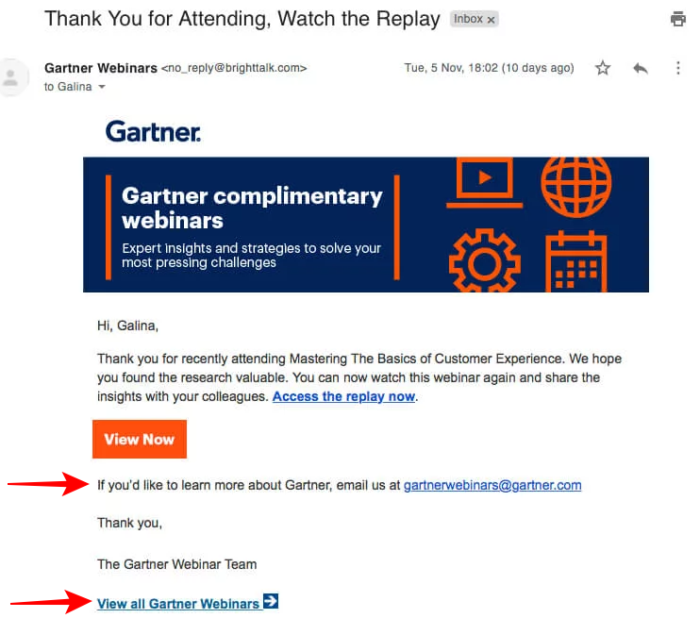
Key insights from this section include:
- The importance of multi-channel touchpoints to build trust and visibility
- Stats showing repeated exposure increases conversion likelihood
- Simple, non-intrusive ways to continue the conversation outside of email
By implementing a thoughtful follow-up strategy, you can enhance your chances of converting leads into clients and drive engagement with your offerings.
If you want to get your marketing work done for your business (or for your clients’), then you HAVE to learn more how you can delegate unlimited marketing projects & tasks without the headaches of hiring. Download this free guide: 33 Examples of Marketing Projects You Can Delegate to Growbo
CONCLUSION
In summary, mastering your webinar follow-up strategy is essential for turning attendees into clients. By focusing on personalized communication, engaging subject lines, and clear calls-to-action, you can significantly improve your chances of converting leads. Effective follow-up is not just about sending emails; it’s about building relationships and providing value to your audience.
Key insights from this article include:
- Personalize Your Emails: Use the recipient's name and reference specific content from the webinar to make your emails feel tailored.
- Create Engaging Subject Lines: Craft subject lines that spark curiosity and clearly convey the email's purpose to increase open rates.
- Summarize Key Insights: Recap the main points from the webinar to reinforce learning and encourage action.
- Include Clear Calls-to-Action: Direct your audience on what steps to take next, whether it's scheduling a consultation or accessing additional resources.
- Gather Feedback: Ask for feedback to understand your audience better and improve future communications.
By implementing these 11 crucial webinar follow-up email elements, you can effectively engage your audience, build meaningful connections, and convert your webinar attendees into loyal clients.
If you're ready to elevate your webinar follow-up strategy that not only nurtures leads but drives real conversions, we're here to help. For just $7 for 7 days, Growbo's expert team will help you develop a comprehensive webinar follow-up sequence tailored to your specific audience. From crafting attention-grabbing subject lines to designing persuasive calls-to-action—we handle every detail.
- Customized email sequences for your target audience
- Strategic content that highlights your webinar's key insights
- Professionally written and formatted follow-up messages
- No long-term contracts or commitments
Schedule your consultation today and start turning webinar participants into valuable clients. Have questions about webinar follow-up strategies? Let's connect in the comments below.
Keep Growin', Stay Focused,
Image Credits:
1 - https://selzy.com/en/blog/webinar-follow-up-email/
2 - https://ewebinar.com/blog/effective-webinar-email-sequences
3 - https://www.digistorms.com/blog/webinar-follow-up-email
4 - https://univid.io/blog/boost-webinar-conversion-rates-cta-examples/
5 - https://ewebinar.com/blog/effective-webinar-email-sequences
6 - https://www.glueup.com/blog/webinar-follow-up-email
7 - https://mailshake.com/features/follow-ups/
8 - https://zapier.com/blog/ab-testing-email-marketing/
9-https://myownconference.com/blog/en/webinar-follow-up-email/










